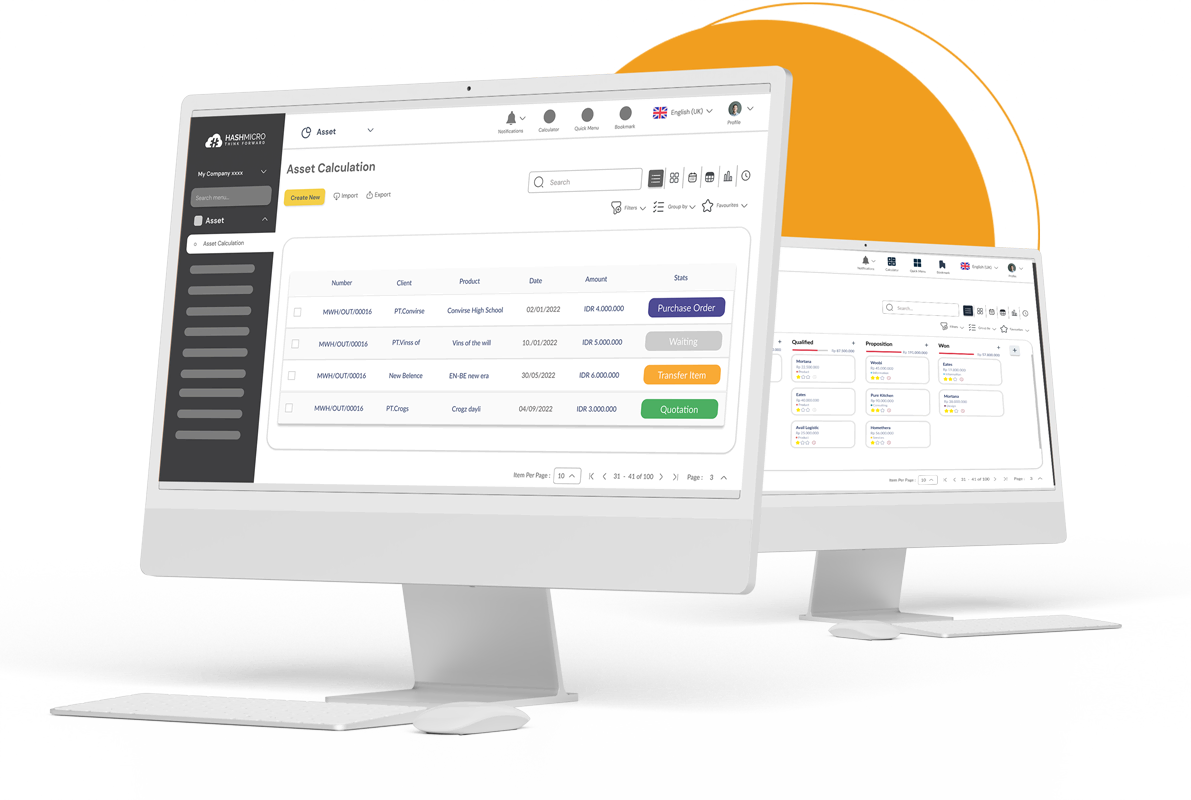Are you struggling to manage your company’s extensive assets, still relying on Microsoft Excel? Consider adopting asset management software. This system efficiently oversees the lifecycle of software programs, minimizing risks, reducing errors, and saving time and operational costs.
Many companies in Singapore maintain a complex asset management. Modernize your approach with a cloud-based asset management system, automating your entire workflow. The real-time data generated helps you make informed decisions for your business’s future.
In this article, we will delve deeper into what an asset management system is and how it will enhance your business in Singapore.
Key Takeaways
|
Table of Content:
Table of Content
What is Asset Management Software?
An asset management system is a comprehensive software employed by businessman to oversee and control a diverse array of assets, encompassing both tangible and intangible elements such as personnel, buildings, software, hardware, and inventory.
This entails the utilization of tools, methodologies, and software to align with the company’s asset management policies and objectives, aiming to optimize returns, minimize losses, and ensure efficient utilization across the entire asset lifecycle.
The purpose of implementing the best asset management software is to aid companies in effectively monitoring fixed assets like IT equipment, industrial resources, vehicles, and essential tools for organizational operations and profitability.
The asset management system typically involves the use of various technologies such as barcodes, QR codes, RFID (Radio-Frequency Identification), GPS (Global Positioning System), or a combination of these to track and manage assets. For instance, QR Codes can be employed to streamline asset tracking by providing easily scannable information.
Implementing an asset management software can lead to increased operational efficiency, reduced costs, and improved overall management of valuable resources within an organization.
How Asset Management Works
Asset management is the strategic oversight and optimization of a business’s diverse assets, including physical and intangible elements, to enhance overall performance and align with organizational goals, typically overseen by an appointed asset manager.
It involves the entire lifecycle of assets, from acquisition to disposal, aiming to maximize value and minimize risks. The implementation of asset management begins by appointing a dedicated asset manager responsible for the oversight and maintenance of all business assets, ranging from equipment and inventory to personnel.
It is crucial to note that assets encompass a diverse array within the business framework. The asset manager formulates a comprehensive and efficient plan for asset management.
Once established, this plan enables the execution, operation, maintenance, and cost-effective control of the company’s asset disposition. The asset manager possesses a thorough understanding of both the operational and strategic facets of the company’s processes.
Thus, a holistic approach to asset management is imperative, involving a comprehensive view of the entire lifecycle of each asset.
Asset Management Software Features
These key features collectively establish a sophisticated asset management system tailored to the specific needs of Singaporean businesses. The features of this system not only enhance operational efficiency but also provide detailed insights for informed decision-making and strategic planning.
Here are the asset management software features:
1. Assets overview
Asset management system provides an extensive overview of your assets, empowering you with the tools to generate detailed reports that delve into the financial aspects of asset costs. These reports offer a nuanced understanding of financial implications, enabling strategic financial planning and decision-making.
Additionally, the system allows you to monitor and control maintenance budgets effectively. This ensures that spending on asset upkeep is optimized, promoting cost-effective maintenance practices that can significantly reduce overall expenses while maintaining high standards of asset management.
2. Maintenance management
The maintenance management capabilities of asset management system are designed to enhance the longevity and reliability of your assets. By implementing preventive maintenance scheduling, the system proactively addresses potential issues before they escalate, effectively extending the lifespan of your assets.
Additionally, it streamlines repair order management by seamlessly integrating with your inventory systems. This integration fosters efficiency in maintenance operations, ensuring that repairs are conducted promptly and resources are utilized optimally, thus minimizing downtime and enhancing productivity.
3. Inventory control
The inventory control functionality of asset management software simplifies the process of conducting asset stock takes through the use of advanced barcode scanning technology. This method minimizes human errors and significantly enhances the accuracy of your inventory records.
Additionally, the system offers seamless integration with accounting systems, enabling precise tracking of asset depreciation. This integration is crucial for accurate financial planning and reporting, providing valuable insights into the financial health of your assets over time.
4. Asset tracking
The asset tracking capabilities of asset management system leverage GPS technology to provide real-time, precise location monitoring of assets. This advanced tracking ensures effective logistics management and minimizes the risk of asset loss, thereby safeguarding your valuable resources.
Additionally, the asset management system supports a hierarchical organization of assets through its parent and child asset management feature. This functionality allows for a more structured and organized approach to asset management, facilitating easier oversight and more efficient allocation of assets across different levels of the organization.
5. Facility management
The facility management of asset management software optimizes the handling of facility requests through the innovative use of QR code scanning. This streamlined process not only simplifies the submission and tracking of requests but also significantly reduces the response times, enhancing user satisfaction and operational efficiency.
Additionally, the system facilitates the efficient management of employee facility or asset rentals. By ensuring seamless transactions and optimized utilization, it prevents bottlenecks and maximizes the availability and use of facilities and assets.
6. Vehicle management
The vehicle management of asset management software functionalities are meticulously designed to enhance the efficiency of your fleet. By integrating fuel log and odometer tracking, the system promotes cost-effective fuel management and ensures that maintenance is timely and based on actual vehicle usage. This helps in prolonging the life of vehicles and reducing maintenance costs.
Furthermore, the asset management system includes an Asset Move functionality that facilitates smooth transitions during the relocation of assets. This feature ensures that asset records are accurately updated in real time, preventing discrepancies and improving the reliability of asset tracking during moves.
7. Integrated operations
The integrated operations feature of asset management software provides a comprehensive solution for financial tracking by fully integrating with existing accounting systems. This integration offers a holistic view of all asset-related expenses, enabling more informed financial decisions and streamlined budgeting processes.
Additionally, the system enhances the management of employee assets, facilitating efficient handling throughout their entire lifecycle—from acquisition to disposal. This streamlined process ensures that personnel assets are effectively managed, maintained, and updated.
8. Request handling
The request handling capabilities of asset management system are designed to manage asset and vehicle maintenance requests comprehensively, ensuring a prompt and organized response to maintenance needs. This feature allows for a more systematic approach to maintenance scheduling and execution, which not only extends the lifespan of assets but also enhances operational efficiency.
Additionally, the system ensures accurate monitoring of asset locations, significantly enhancing security and reducing the risk of misplacement or loss. This tracking capability is critical in maintaining tight control over asset inventory, providing peace of mind and added reliability in the management of valuable resources.
Benefits of Asset Management System
Here are the benefits of asset management software:
- Comprehensive lifecycle oversight
- Enhanced compliance and transparency
- Strategic asset utilization and cost mitigation
- Maximized equipment lifecycles and operational efficiency
- Cloud-based agility and future-proofing
- Efficient barcode and QR code generation
For detailed explanations along with the risks and challenges of managing your business’ assets manually, read this article about asset management system advantages.
In essence, the adoption of an advanced asset management system empowers businesses to optimize their operational efficiency, reduce costs, ensure compliance, and strategically position themselves for future growth.
Embracing the comprehensive benefits outlined above positions organizations to achieve unparalleled success in today’s competitive business landscape.
Moreover, the pricing of the system can be pretty affordable. You can look at the pricing scheme of one of the most recommended asset reservation systems in Singapore by clicking the image below.
Challenges of Implementing an Asset Management System
Implementing an asset management system can drive efficiency, but it comes with challenges. Data Accuracy is a key hurdle, as reliable data is essential to making informed decisions. This requires regular updates and audits to keep the information accurate.
Another challenge is System Integration—merging the asset management system with existing tools like ERP or financial systems can be complex. Ensuring a smooth integration avoids data silos and enhances workflow efficiency.
Cost and Resource Allocation also play a significant role. Implementing and maintaining such a system demands a considerable investment in time, money, and personnel, which can be daunting for smaller organizations.
Further, User Adoption and Training is crucial. Without proper training, employees may not fully utilize the system, reducing its effectiveness.
Lastly, Security and Compliance are essential to safeguard sensitive asset data and adhere to industry regulations. Robust cybersecurity measures are needed to protect against breaches and maintain compliance.
Overcoming these challenges is vital to fully realizing the benefits of an asset management system, from optimized workflows to better asset tracking.
Finding The Right Software
choosing the right software is more critical than ever. The software you select can streamline operations, enhance productivity, and drive your business toward success. However, with countless options available, navigating this selection process can be daunting.
To make an informed decision, it’s essential to assess your specific needs, explore features that align with your goals, and consider the long-term implications of your choice.
To start, identify your business’s unique requirements—whether for asset management, customer relationship management, or project coordination. Evaluate software options by examining key factors like ease of use, scalability for future growth, integration with existing tools, and quality of customer support.
Testing potential solutions through free trials or demos provides firsthand experience with the tool, helping you make an informed choice. Involving team members in the selection process can also ensure the software aligns with daily workflows. The right software doesn’t just streamline tasks—it becomes a cornerstone of your organization’s growth and adaptability
Utilizing Today’s Technology for Asset Management
In the dynamic landscape of Singapore’s business operations, efficient asset management system is imperative for compliance with international standards and optimizing returns while minimizing costs and risks.
Leveraging technology, especially asset management software, becomes crucial for controlling and preserving software assets throughout their lifecycle, whether on-premises or in the cloud.
Choosing the right asset management software requires thorough consideration, reviews, and a complimentary demo. Positive reviews, reasonable pricing, and seamless integration should guide the decision-making process. To explore more, read this article about the best asset management software in Singapore.
Conclusion
Navigating the asset management process can be arduous when relying on manual methods like spreadsheets or Microsoft Excel. The continuous demand for data updates necessitates meticulousness and precision from every team member. Moreover, the susceptibility to human errors makes this approach impractical.
In stark contrast, leveraging HashMicro’s cutting-edge asset management software transforms this challenge into seamless efficiency. This advanced system simplifies and expedites asset management, ensuring a hassle-free experience.
For further details about our comprehensive asset management system, please reach out to our dedicated support team and try out the free demo.

Questions About Asset Management Software
What’s the best asset management software in Singapore?
HashMicro is the best asset management software in Singapore. It offers various comprehensive features and benefits, with advanced integration to other modules. Trusted by more than 1750 companies, HashMicro is an ideal choice to leverage an asset management system.Can asset management software replace traditional methods like Excel for asset tracking?
Yes, asset management software is designed to replace traditional methods like Excel, providing more accurate and efficient tracking, reducing errors, and saving time and operational costs.Are there any specific benefits of implementing asset management software in Singapore?
In Singapore, implementing asset management software can help businesses comply with local regulations, manage assets efficiently in a dynamic business environment, and position themselves competitively in the market.What types of assets can be managed using asset management software?
Asset management software can manage a wide range of assets, including physical items like vehicles and equipment, as well as intangible assets such as software and intellectual property.







































